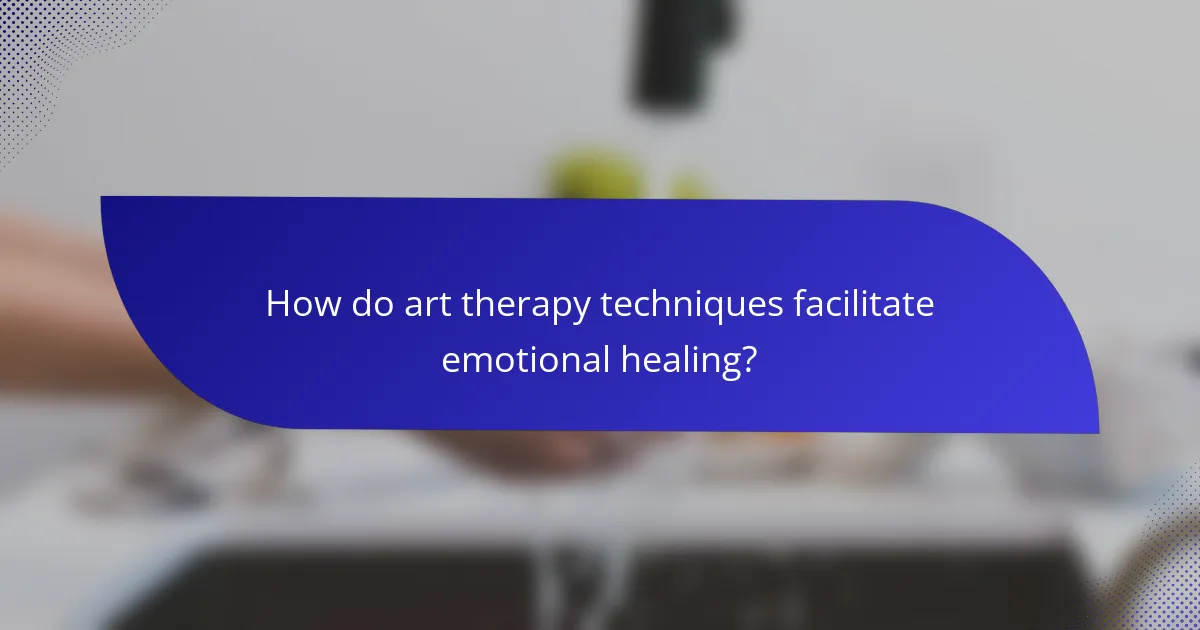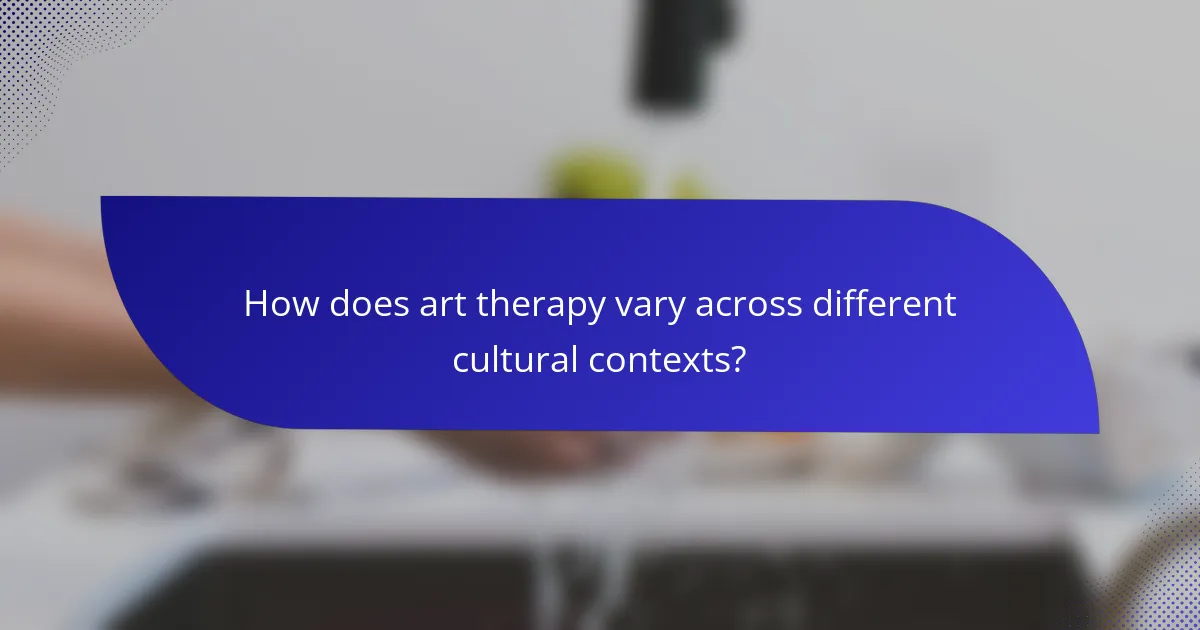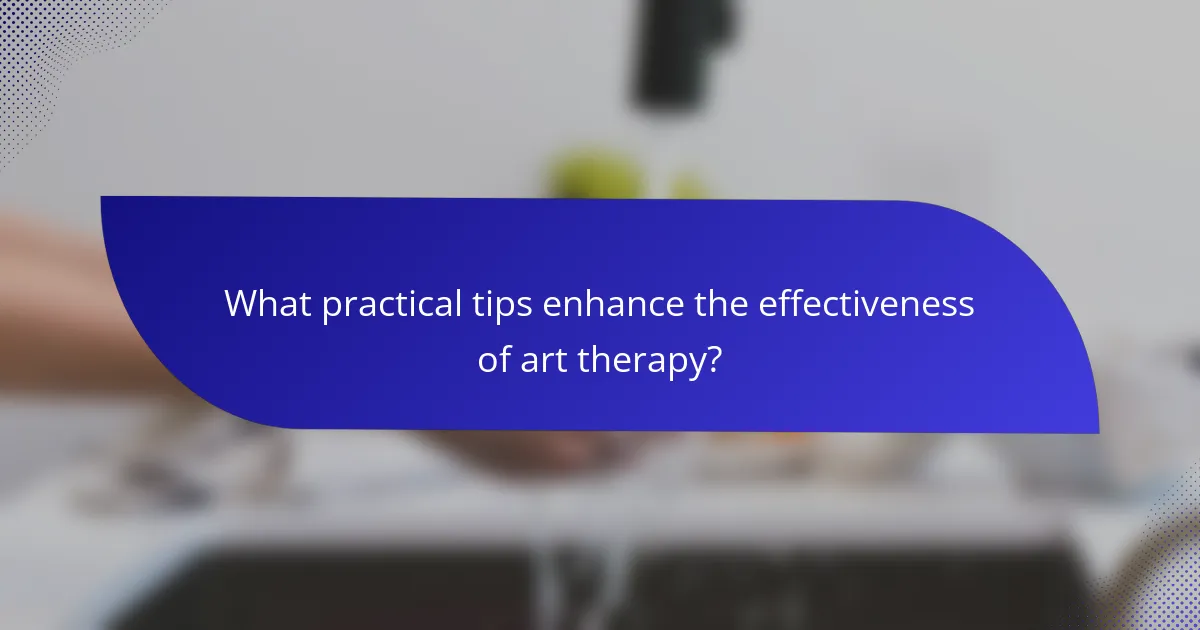Art therapy techniques enhance creativity and promote emotional healing through self-expression and introspection. Engaging in activities like painting and drawing reduces anxiety and improves mood. Cultural contexts shape these techniques, reflecting diverse practices and beliefs. Challenges such as emotional resistance can arise, but practical tips can facilitate a more effective therapeutic experience.

How do art therapy techniques facilitate emotional healing?
Art therapy techniques facilitate emotional healing by enabling self-expression and promoting introspection. Engaging in creative activities allows individuals to explore feelings non-verbally, which can lead to insights and emotional release. Techniques like painting, drawing, and sculpting help reduce anxiety and improve mood. Research indicates that art therapy can significantly lower symptoms of depression and PTSD. These techniques foster resilience by allowing individuals to visualize their emotions, enhancing coping strategies.
What psychological principles underpin art therapy?
Art therapy is underpinned by psychological principles such as expression, processing emotions, and fostering creativity. These principles facilitate healing by allowing individuals to communicate feelings non-verbally. Techniques like free drawing and collage-making enhance self-exploration and emotional release. Research indicates that art therapy can reduce anxiety and improve mood, supporting its efficacy in emotional healing. The unique attribute of art therapy lies in its ability to provide a safe space for individuals to confront and express complex emotions creatively.
Which art therapy techniques are most effective for emotional trauma?
Art therapy techniques that effectively address emotional trauma include expressive art, guided imagery, and narrative therapy. These methods foster self-expression, enhance coping skills, and promote healing.
Expressive art allows individuals to convey emotions through various mediums, facilitating emotional release. Guided imagery employs visualization to create calming mental spaces, aiding relaxation and trauma processing. Narrative therapy encourages storytelling, helping individuals reframe their experiences and gain perspective.
Research indicates that these techniques can significantly reduce symptoms of anxiety and depression in trauma survivors. For example, a study found that participants engaging in expressive art reported a 60% decrease in emotional distress.
How does creative expression impact mental health?
Creative expression significantly enhances mental health by promoting emotional healing and creativity. Art therapy techniques facilitate self-exploration and emotional release, leading to improved mental well-being.
Engaging in artistic activities, such as painting or music, allows individuals to process emotions and experiences. Studies indicate that art therapy can reduce symptoms of anxiety and depression, fostering a sense of accomplishment and purpose.
Furthermore, art therapy techniques often include guided imagery and expressive writing, which encourage deeper emotional insights. These methods can help individuals articulate feelings that may be difficult to express verbally.
Overall, creative expression through art therapy serves as a powerful tool for mental health enhancement, supporting emotional healing and personal growth.

What role does creativity play in art therapy?
Creativity is essential in art therapy as it fosters self-expression and emotional healing. Engaging in creative processes allows individuals to explore feelings, reduce anxiety, and enhance problem-solving skills. Techniques such as painting, drawing, and sculpting provide a safe outlet for emotions, leading to increased self-awareness and personal growth. As a result, creativity in art therapy not only promotes emotional well-being but also empowers individuals to communicate their experiences in unique ways.
How can art therapy enhance creative thinking?
Art therapy enhances creative thinking by providing a safe space for self-expression and exploration. It encourages individuals to use various artistic mediums, fostering innovative thought processes. Techniques such as free drawing, collage-making, and guided imagery stimulate imagination and help break mental barriers. As a result, participants often experience improved problem-solving skills and heightened emotional awareness. Engaging in art therapy can lead to unique insights and personal growth, making it a valuable tool for enhancing creativity.
Which artistic mediums are most beneficial for creative exploration?
Artistic mediums such as painting, sculpture, and music are highly beneficial for creative exploration. These mediums facilitate emotional expression and enhance problem-solving skills.
Painting allows for visual storytelling, enabling individuals to convey emotions through colors and forms. Sculpture provides a tactile experience, fostering spatial awareness and three-dimensional thinking. Music engages auditory senses, promoting emotional release and cognitive flexibility.
Art therapy techniques utilizing these mediums can lead to improved mental health outcomes. Studies show that engaging in artistic activities reduces anxiety and depression while enhancing self-esteem and resilience.

How does art therapy vary across different cultural contexts?
Art therapy varies significantly across cultural contexts, reflecting diverse beliefs and practices. Techniques often incorporate local art forms, traditions, and community values. For example, Indigenous cultures may use storytelling and nature-based art to facilitate healing, while Western approaches might focus on structured techniques like guided imagery or expressive arts. Cultural sensitivity is crucial, as it enhances emotional connection and promotes effective healing. Additionally, art therapy can address specific cultural traumas, making it a unique tool for emotional expression and recovery.
What are the regional adaptations of art therapy practices?
Regional adaptations of art therapy practices vary significantly based on cultural contexts and community needs. In Western countries, techniques often emphasize individual expression through various mediums like painting and sculpture. In contrast, Eastern practices may integrate traditional forms such as calligraphy and pottery, fostering collective healing experiences.
Indigenous communities frequently blend storytelling with art, using cultural symbols to address trauma and promote resilience. Additionally, urban settings may focus on street art as a means of social commentary and empowerment. Art therapy’s adaptability across regions highlights its effectiveness in enhancing creativity and emotional healing through culturally relevant methods.
Which cultural beliefs influence the perception of art therapy?
Cultural beliefs significantly shape the perception of art therapy. Different cultures view emotional expression and healing through art uniquely, influencing acceptance and techniques used. For instance, some cultures emphasize community involvement in healing, while others focus on individual expression. This diversity affects how art therapy is practiced and perceived globally. Understanding these cultural nuances enhances the effectiveness of art therapy in various settings.

What unique attributes distinguish art therapy techniques?
Art therapy techniques are distinguished by their unique attributes such as creativity enhancement, emotional expression, and non-verbal communication. These techniques often utilize various mediums like painting, sculpture, and drawing to facilitate healing. Each method fosters a distinct environment that encourages individuals to explore their feelings and thoughts visually. Additionally, the personalization of techniques to suit individual needs showcases their unique adaptability in therapeutic settings.
How do personal experiences shape the effectiveness of art therapy?
Personal experiences significantly enhance the effectiveness of art therapy by fostering deeper emotional connections. Individuals draw on their unique backgrounds to express feelings through creativity. This process can lead to profound insights and healing. For example, a person who has experienced trauma may find solace in creating art that reflects their journey, enabling emotional release and understanding. Additionally, art therapy techniques can be tailored to individual experiences, enhancing both creativity and emotional healing. As a result, the therapeutic impact is often more profound and personalized.
What specific populations benefit from tailored art therapy approaches?
Tailored art therapy approaches benefit various populations, including children, individuals with trauma, the elderly, and those with mental health disorders. Each group experiences unique challenges that art therapy can address effectively.
Children often use art to express feelings they cannot verbalize, fostering emotional development. Individuals with trauma may find healing through creative expression, allowing them to process experiences safely. The elderly benefit from art therapy by enhancing cognitive function and reducing feelings of isolation. Those with mental health disorders can use art to explore emotions and develop coping strategies, improving overall well-being.
Research supports these benefits, highlighting art therapy’s role in enhancing creativity and emotional healing across diverse populations.

What are the common challenges faced in art therapy sessions?
Common challenges in art therapy sessions include emotional resistance, lack of trust, and difficulty in expressing feelings through art. Clients may struggle with vulnerability, impacting their engagement. Additionally, logistical issues like space and materials can hinder creativity. Lastly, therapists must navigate varying skill levels, which can affect session dynamics.
How can therapists address resistance to creative expression?
Therapists can address resistance to creative expression by fostering a safe environment and using specific art therapy techniques. Establishing trust is crucial; clients need to feel secure to explore their emotions. Techniques such as guided imagery, where clients visualize scenarios before creating art, can help ease anxiety. Additionally, using non-threatening materials like clay or watercolors allows for freedom of expression without the pressure of traditional art forms. Encouraging spontaneous creation without judgment promotes exploration and can break down barriers to creativity. Finally, integrating discussions about the art process can help clients articulate their feelings, enhancing emotional healing.
What limitations should clients be aware of in art therapy?
Clients should be aware that art therapy may not suit everyone and has certain limitations. Individual differences in emotional readiness can affect outcomes. Some clients may struggle with self-expression through art, which can hinder progress. Additionally, art therapy is not a substitute for medical treatment of severe mental health issues. It is essential to understand that results vary based on personal engagement and therapeutic relationship. Finally, access to qualified art therapists can be limited, impacting availability and consistency of care.

What practical tips enhance the effectiveness of art therapy?
Engaging in art therapy can be enhanced through various practical tips. First, create a designated space free from distractions to encourage creativity. Second, set specific goals for each session, which can guide the artistic process. Third, explore diverse materials, as using different mediums can inspire new ideas. Fourth, embrace spontaneity; allow emotions to flow without judgment. Lastly, reflect on the artwork created, as this can deepen emotional understanding and healing.
Which strategies can clients use to maximize their art therapy experience?
Clients can maximize their art therapy experience by actively engaging in the process and setting clear intentions. Establishing a safe environment enhances creativity and emotional expression. Regular practice of art techniques, such as painting or sculpting, fosters skill development and emotional release. Seeking feedback from the therapist can guide personal growth and deepen insights. Exploring various art forms broadens creative expression, allowing clients to discover new ways to articulate feelings.
What common mistakes should be avoided during art therapy?
Common mistakes to avoid during art therapy include overemphasizing technical skill, neglecting emotional expression, and rushing the creative process. Participants may focus too much on producing aesthetically pleasing art rather than exploring feelings. This can hinder emotional healing. Additionally, failing to create a safe space for self-expression can limit the therapeutic benefits. Lastly, not allowing sufficient time for reflection can prevent deeper insights and growth.